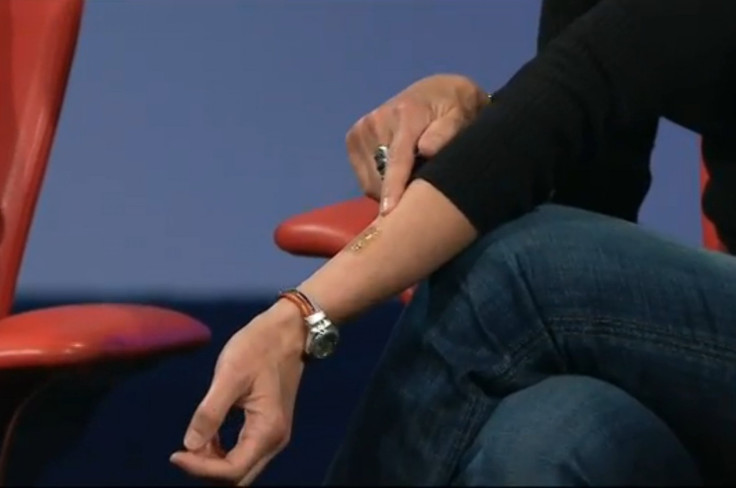Google: Pill Passwords And Electronic Tattoos In The Works As Motorola Focuses On Innovating Authentication Methods [VIDEO]

Motorola has always been known for its phones, but since Google officially acquired Motorola Mobility in 2012, the company has also been working on a number of special projects besides smartphones, using advanced, experimental technology. On Wednesday, Motorola chief Dennis Woodside and special projects lead Regina Dugan sat down with Walt Mossberg at the D11 Conference in Rancho Palos Verdes, Calif., to discuss the company’s future in mobile innovation.

“I joined the scrappy underdog team,” Dugan said of Google, which she joined in March 2012. “I like that environment. We got to do a lot of epic s--t when I was at DARPA, and it was clear I wanted to do more of that. We challenge everything, not just about the projects we’re doing but also how we’re doing innovation.”
Dugan explained how she instilled the same sense of innovation from her years as director of DARPA, by focusing less on the “linear strategy that goes from basic research to applied research to projectization and commercialization,” and centering more on the intersection of big science and driving applications.
“Lots of people talk about innovation in this space as if the big innovations have already happened,” Dugan said. “I think that’s a lack of imagination, frankly. There are so many unsolved problems and there are so many opportunities that can be realized in the [technology] here.”
Dugan pointed out one particularly important technology that people find important but irritating: authentication. She argued that people are significantly more prone to identity theft without authentication methods, but only about “half the people do it.”
“After 40 years of advances in computation, we’re still authenticating the same way we did years ago,” Dugan said. “In fact, it’s gotten worse, because you don’t do it once a day or twice a day, users are doing them 39 times a day and it takes them 2.3 seconds every time they do it; power users do it up to 100 times a day. We’re thinking of a whole variety of options for how you could do better at authentication. You can start with nearer-term things like tokens or FOBs that might have NFC or Bluetooth embedded in them, or you can also think about a means of authentication that you could simply wear on your skin every day -- like an electronic tattoo.”
Dugan described her “profound interest” in wearables -- poking fun at comments previously made by Apple CEO Tim Cook -- but said that there were still a number of fundamental problems with wearables, the most important being the “mechanical mismatch” between humans and machines. “Electronics are boxy and rigid, humans are curvy and soft,” Dugan said. But she also mentioned how scientists from Northwestern University and University of Illinois had created a lithium-ion battery comprised of “accordion-like structures” that allowed it to stretch up to 300 percent of its original size and still function, insinuating that there’s great potential in making devices as flexible as the human body.
At this point in the conversation, Dugan rolled up her sleeve to show off a small Band-Aid shape “tattoo” planted on her forearm.

“This is a developmental system made by MC10 and it has an antenna and some sensors embedded in it, and what we plan to do is work with them to make a tattoo that can be used for authentication,” Dugan explained. “It’s possible that 10- and 20-year-olds don’t want to wear a watch on their wrist, but you can be sure they’ll be far more interested in wearing an electronic tattoo if only to piss off their parents.”
Dugan said authentication could be a fashion statement, but it could also become part of our daily habits.
“I take a vitamin every morning, what if I could take vitamin authentication?” Dugan asked, shortly before pulling such a pill out of her pocket.
“This pill has a small chip inside of it with a switch,” she said. “It also has what amounts to an inside-out potato battery. When you swallow it, the acids in your stomach serve as the electrolyte and power it up, and the switch goes on and off. It creates an 18-bit ECG like signal in your body so essentially your entire body becomes your authentication token.”
Dugan called the “password pill” her “first superpower.”
“It means my arms are like wires and my hands are like alligator clips [so] when I touch my phone, my computer, my door, I’m authenticated,” Dugan said. “This is not science fiction.”

Dugan explained that the password pill is actually manufactured by Redwood City, Calif.-based Proteus, which originally developed the vitamin for medical applications. But while the pill is CE-stamped and FDA-approved -- Dugan contends that humans could take 30 of those pills per day for the rest of your life -- Motorola’s Woodside asserted that the pill is not quite ready for primetime.
“There’s a lot of work to do, this isn’t going to ship anytime soon, but I think having the boldness to think differently about problems people have every day is really important for Motorola now,” Woodside said. “We’re trying to get the company in the mindset to think big again. And it’s early, but we’re excited about where it’s going.”
Watch the full video interview with Mossberg, Woodside and Dugan below, and let us know your thoughts on these authentication innovations in the comments section towards the bottom of the page.
© Copyright IBTimes 2024. All rights reserved.





















